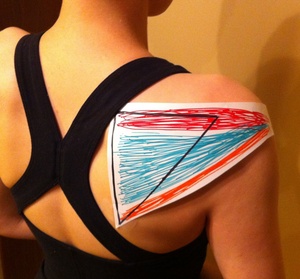Anatomy Made Easy: The rotator cuff

This photo shows the approximate locations of three out of the four rotator cuff muscles. Notice that most of the bulk of the muscles is on my back. The black outline represents the shoulder blade which all of the rotator cuff muscles attach to. The fourth rotator cuff muscle lies underneath the shoulder blade so we cannot see it in this picture.
Photo courtesy of Matt Wilson
What is the rotator cuff? I'm sure you have heard of it. You have probably been told at some point that either you or someone you know has a torn rotator cuff, a common shoulder injury. I have had clients at my studio tell me their rotator cuff is a bone, a single muscle, the big meaty muscle that caps the shoulder, a muscle in their chest, or a ring of muscle that loops around the top of the arm bone and doesn’t attach to anything else. In fact, it is none of these.
Allow me to take a short detour. I have a strong belief every person should have a good understanding of their own body, how it works, and what its basic parts are. Having a better understanding of your body can give you a sense of empowerment in making medical decisions for yourself.
Increasing your awareness of your own body may also help you to avoid injury -- if you pay attention to warning signs early and seek help for them then you can often head off difficult problems before they get entrenched. Gaining an accurate picture of how your body is put together can help you to increase this awareness.
The many (incorrect) variations in rotator cuff perception are one example of how little the average person know about this amazing "machine" they carry around everywhere with them. I know many people have a perception of anatomy as difficult and/or boring so it is my goal in these posts to bring you bite-sized pieces of anatomy made easy: just enough so you learn something about yourself, not enough to make you abandon me in boredom or frustration.
Returning to the rotator cuff. It is a group of four muscles that attach from your shoulder blade (one of my clients calls it the wing bone) to your upper arm bone. These muscles perform important functions in moving your arm and helping to hold your shoulder in its joint.
According to Joseph Muscolino in The Muscular System Manual, "[The rotator cuff muscles'] role as fixators (stabilizers) is especially important and necessary, because the ligamentous structure of the shoulder joint is very lax and more stability must be provided by the muscles of the shoulder." In English: your shoulder wouldn't move and stay in joint without the work of these important muscles! In addition to stabilizing the shoulder, the different muscles of your rotator cuff rotate your arm in and out (thus their name) as well as lift your arm to the side.
Because of their central role in arm movement and stabilization, these muscles often get injured. According to MayoClinic.com: "Causes of a rotator cuff injury may include falling, lifting and repetitive arm activities; especially those done overhead, such as throwing a baseball or placing items on overhead shelves. About half of the time, a rotator cuff injury can heal with self-care measures or exercise therapy."
The next time you move your arm, thank your rotator cuff muscles for making it possible!
Heather Glidden owns Willow Wellness Studio in downtown Ann Arbor where she teaches Gyrotonic and Pilates and practices massage. She is passionate about helping people to learn more about their bodies. Got a body question? Email her at info@WillowWellnessStudio.com and she will do her best to answer it or find someone who can!


Comments
Heather Glidden
Tue, Nov 9, 2010 : 5:36 p.m.
My next target is 'the core': http://www.annarbor.com/health/anatomy-made-easy-what-is-the-core/. I will try to get to various topics that I get questions about at my studio. Thank you for the suggestions!
JE
Mon, Nov 1, 2010 : 8:32 p.m.
Heather, Thanks for this info. What body part is next on your list? How about knees or hands/wrist. Then maybe hips, toes/feet and ankles. All parts that most people have problems with sometime in their lives.